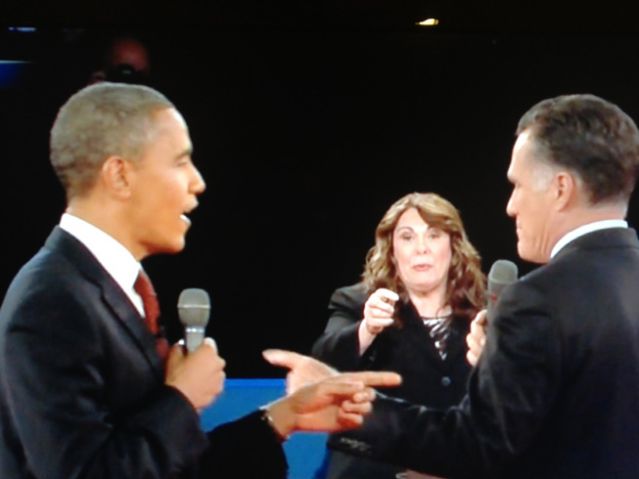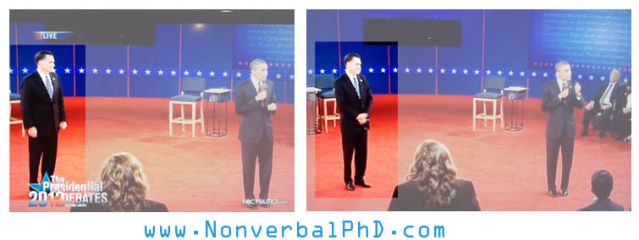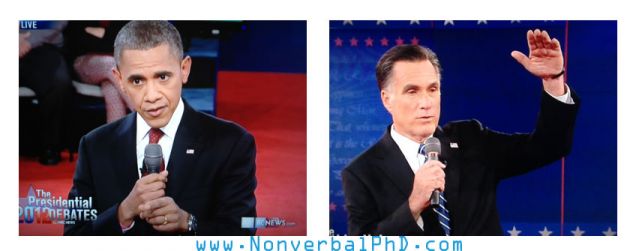Body Language
The Science of Body Language & The Debates
Research Shows That Yes, Body Language Does Matter.
Posted October 21, 2012
Body language evaluation has increasingly become more scrutinized as each debate passes and expect it to continue with the final debate between President Obama and Governor Romney. Media pundits, nonverbal communication experts and researchers, politicians, and the general audience have all been more than willing to share their thoughts and interpretations.
With such a large amount of people weighing in, differences are certain to appear.

You don't have to always point to make a point.
EVERYONE IS AN “EXPERT”- WHO TO BELIEVE?
The question becomes who do you believe, and what are their comments and analysis based on? How do you determine the difference between opinions and facts?
The issue that arises often with nonverbal communication is that it is both a science and an art. An example is eye contact is a sign of building rapport (science) yet how one applies it (the “art”) can have an adverse effect (think a “cold” “hard” stare).
This article offers an overview of relevant research in nonverbal communication and offers tips on how you can apply it to the debates. This will allow you to make a more informed interpretation of the nonverbal communication used by the candidates and more accurately evaluate the numerous body language evaluations that will be offered post debate in the media.
WHAT THE RESEARCH SAYS*
1. (Seiter et al., 1998) the facial expressions of a speaker’s opponent during a debate affected judgements of the speaker. When the opponent displayed disagreement by rolling his eyes, shaking his head… viewers had more positive attitudes toward the speaker, rating him higher on competence, character, composure, and sociability.
2. (Seiter, 2001) When a nonspeaking debater expressed nearly continuous disbelief by frowning, head shaking, mouthing “no” or “what?” audience members regarded him as deceptive and the speaker as truthful. However, moderate signs of disbelief lowered the ratings of truthfulness for both speakers.
3. (Smith, 2000) People speculated how much Gore’s “rude” behavior of occasional sighs of exasperation that were easy to hear may have damaged his performance.
4. (Luntz Research Companies, 2004) President Bush’s smirks, grimaces, and contorted facial expressions during his debate with John Kerry were so pronounced that they actually undermined his support among many undecided voters.
5. (Burgoon et al., 1996) Persuasiveness of a speaker includes the following nonverbal behaviors: eye contact, forceful gestures, open body positions, head nodding, close distances, touch, facial pleasantness, fluent speech, moderately loud vocal tones, moderately fast speech, and pitch variation.
6. (O’Keefe, 1990) The more a listener is focused on the issue, the less likely they are influenced by the speaker’s nonverbal cues.
7. (Exline, 1985) in regards to the Carter-Ford 1976 presidential debate, power and credibility correlate with greater relaxation and poise. Observers rated more favorably the segments that showed less tension, and tension related adaptors (lip licking, postural sway, shifting gaze, eye blinks, and speech non-fluencies).
8. (Ritter & Henry, 1990) Jimmy Carter’s loss to Ronald Regan in the 1980 debate was attributed to Carter’s visible tension and his inability to coordinate his nonverbal behavior with his verbal message.
9. (Guerrrero & Floyd, 2006) People who communicate in a dynamic fashion have a dramatic, memorable, and attention-grabbing communication style that is immediate, expressive, and energetic.
10. (Cherulnik, et al., 2001) In regards to Bush-Clinton debate, coaching a speaker to act charismatic may not yield the desired effect if the speaker’s nonverbal communication seems deliberate rather than spontaneous.

Notice The difference in Gov Romney's stance- which looks more confident?
Check Your Biases At The Door
Remember when watching the debates, you also possess biases. We all have them and notable biases include in-group bias: giving preferential treatment to those in your own group (the same political party). Another is the fundamental attribution error bias. This is seeing one person’s actions are a result of their disposition while another’s actions is a result of the situation. Acknowledging your biases allows you to be able to then “check” them and conduct a more neutral analysis.
CPR- Charisma, Professionalism, Rapport
Elsewhere I mention the CPR model (charisma, professionalism, and rapport) as a way to analyze each debater. Research states:
(Petland, 2008) Charismatic people are unusually expressive, sensitive, and have strong internal control.
(Fox Cabane, 2012) Power and warmth are needed in order to be charismatic. Someone who is powerful but not warm can be impressive but isn’t necessarily perceived as charismatic and can come across as arrogant, cold, or standoffish. Someone who possesses warmth without power can be likeable, but is not necessarily perceived as charismatic and can come across as overeager, subservient, or desperate to please.
(Andersen, 2008) Immediacy behaviors are persuasive for several reasons; they may increase perceptions of trustworthiness, and dynamism (charisma), which are both key components underlying credibility. Immediacy behaviors also command attention and reflect interpersonal warmth and liking.
WHAT IS SEMIOTICS?
Semiotics is the study of signs. In this case the signs are the nonverbal communication cues and elements. Semiotic analysis is simple (really!) and applying it to nonverbal communication helps reduce one’s biases. The three steps include
1) Semantics: identify the nonverbal cue (i.e. the gesture, facial expression, or posture),
2) Syntactics: look at it in respect to what else is going on (other cues and/or words spoken), and
3) Pragmatics: analysis based on the context and previous research.
READY?
Now that you are aware of the research and have “checked” your biases, enjoy the next debate. This article has offered insight into the research that contributes to my analysis, a model to view the effectiveness of the nonverbal communication being used and a method to analyze it. With this information, you can conduct your own nonverbal analysis and also compare it to the reviews of others.
Like this article? If yes, you will proably like my tweets too: @NonverbalPhD

Pointing, used sparingly & strategically, along with congruent gestures can be effective.
*This collection of research is primarily from the texts written by: Nonverbal Communication in Human Interaction; ; Nonverbal Communication In Everyday Life; and Nonverbal Communication.




